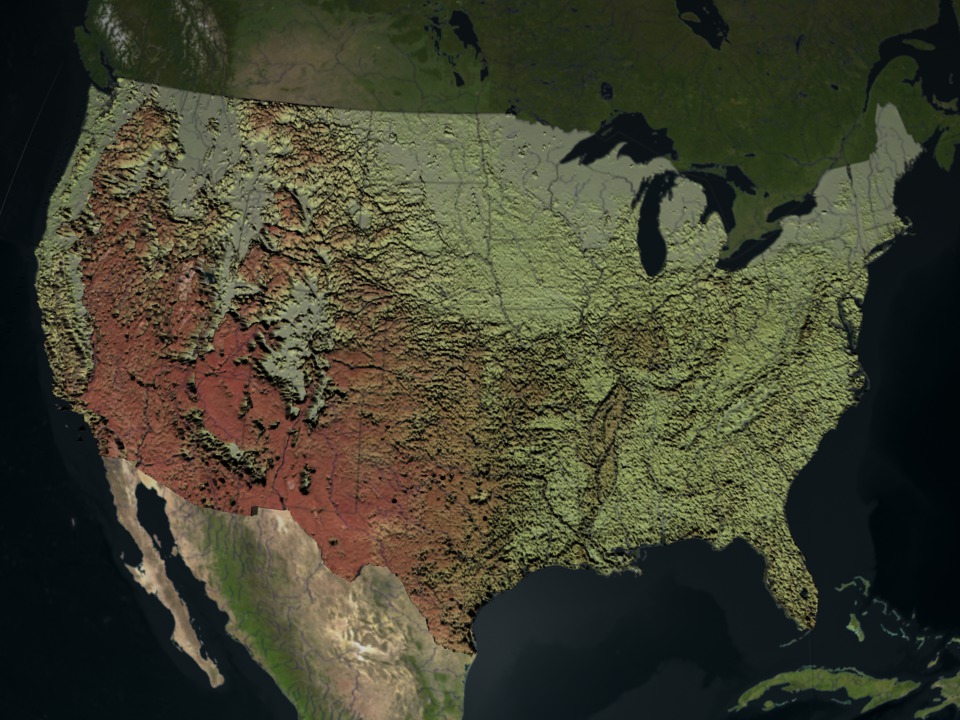Earth
ID: 3291
The spread of invasive species is one of the most daunting environmental, economic, and human-health problems facing the United States and the World today. It is one of several grand challenge environmental problems being addressed by NASA's Science Mission Directorate through a national application partnership with the US Geological Survey. NASA and USGS are working together to develop a National Invasive Species Forecasting System (ISFS) for the management and control of invasive species on Department of Interior and adjacent lands. The system provides a framework for using USGS's early detection and monitoring protocols and predictive models to process MODIS, ETM+, ASTER and commercial remote sensing data, to create on-demand, regional-scale assessments of invasive species likely habitats.
Recent work on the Invasive Species Forecasting System (ISFS) project has shown the importance of remotely-sensed time-series data in geostatistical models for mapping the distribution of Tamarisk and other invasive plant species. This video shows the habitat suitability for a Tamarisk invasion in the continental United States. Red indicates areas that are highly suitable and yellow indicates areas which are less suitable. Texas, New Mexico, and Nevada are the most highly suitable states. Utah and Arizona have the next greatest risk. California, Arizona, Montana, Colorado, Oregon, Ohio, Wyoming, and Florida also have a significant risk.




National Map Showing Habitat Suitability for Tamarisk Invasion
Recent work on the Invasive Species Forecasting System (ISFS) project has shown the importance of remotely-sensed time-series data in geostatistical models for mapping the distribution of Tamarisk and other invasive plant species. This video shows the habitat suitability for a Tamarisk invasion in the continental United States. Red indicates areas that are highly suitable and yellow indicates areas which are less suitable. Texas, New Mexico, and Nevada are the most highly suitable states. Utah and Arizona have the next greatest risk. California, Arizona, Montana, Colorado, Oregon, Ohio, Wyoming, and Florida also have a significant risk.




Visualization Credits
Lori Perkins (NASA/GSFC): Lead Animator
Jeffrey Morisette (NASA/GSFC): Scientist
Jeff Pedelty (NASA/GSFC): Scientist
Jeffrey Morisette (NASA/GSFC): Scientist
Jeff Pedelty (NASA/GSFC): Scientist
Please give credit for this item to:
NASA/Goddard Space Flight Center Scientific Visualization Studio
NASA/Goddard Space Flight Center Scientific Visualization Studio
Science Paper:
http://www.nasa.gov/home/hqnews/2006/feb/HQ_06063_Invasive_species.html
Short URL to share this page:
https://svs.gsfc.nasa.gov/3291
Missions:
Landsat
Terra
Data Used:
Note: While we identify the data sets used in these visualizations, we do not store any further details nor the data sets themselves on our site.
This item is part of this series:
Invasive Species Forecasting System
Keywords:
SVS >> NDVI
SVS >> Time Series
GCMD >> Earth Science >> Biosphere >> Ecological Dynamics >> Invasive Species
GCMD >> Location >> United States Of America
GCMD >> Location >> Arizona
GCMD >> Location >> California
GCMD >> Location >> Colorado
GCMD >> Location >> Florida
GCMD >> Location >> Montana
GCMD >> Location >> Nevada
GCMD >> Location >> New Mexico
GCMD >> Location >> Ohio
GCMD >> Location >> Oregon
GCMD >> Location >> Texas
GCMD >> Location >> Utah
GCMD >> Location >> Wyoming
NASA Science >> Earth
GCMD keywords can be found on the Internet with the following citation: Olsen, L.M., G. Major, K. Shein, J. Scialdone, S. Ritz, T. Stevens, M. Morahan, A. Aleman, R. Vogel, S. Leicester, H. Weir, M. Meaux, S. Grebas, C.Solomon, M. Holland, T. Northcutt, R. A. Restrepo, R. Bilodeau, 2013. NASA/Global Change Master Directory (GCMD) Earth Science Keywords. Version 8.0.0.0.0
Places you might have seen this:
Kansas City InfoZine, KSL-TV (Salt Lake City), KNXV-TV (Phoenix), KUSA-TV (Denver), Richmond Times Dispatch, Space Daily, SpaceRef.com, Topix.net, WJZ-TV (Baltimore), WTVT-TV (Tampa), and Yahoo! News.
http://www.nasa.gov/home/hqnews/2006/feb/HQ_06063_Invasive_species.html
Short URL to share this page:
https://svs.gsfc.nasa.gov/3291
Missions:
Landsat
Terra
Data Used:
Landsat-7/ETM+
08/2005Aqua/MODIS
08/2005NOAA/AVHRR
08/2005Terra/MODIS
08/2005This item is part of this series:
Invasive Species Forecasting System
Keywords:
SVS >> NDVI
SVS >> Time Series
GCMD >> Earth Science >> Biosphere >> Ecological Dynamics >> Invasive Species
GCMD >> Location >> United States Of America
GCMD >> Location >> Arizona
GCMD >> Location >> California
GCMD >> Location >> Colorado
GCMD >> Location >> Florida
GCMD >> Location >> Montana
GCMD >> Location >> Nevada
GCMD >> Location >> New Mexico
GCMD >> Location >> Ohio
GCMD >> Location >> Oregon
GCMD >> Location >> Texas
GCMD >> Location >> Utah
GCMD >> Location >> Wyoming
NASA Science >> Earth
GCMD keywords can be found on the Internet with the following citation: Olsen, L.M., G. Major, K. Shein, J. Scialdone, S. Ritz, T. Stevens, M. Morahan, A. Aleman, R. Vogel, S. Leicester, H. Weir, M. Meaux, S. Grebas, C.Solomon, M. Holland, T. Northcutt, R. A. Restrepo, R. Bilodeau, 2013. NASA/Global Change Master Directory (GCMD) Earth Science Keywords. Version 8.0.0.0.0
Places you might have seen this:
Kansas City InfoZine, KSL-TV (Salt Lake City), KNXV-TV (Phoenix), KUSA-TV (Denver), Richmond Times Dispatch, Space Daily, SpaceRef.com, Topix.net, WJZ-TV (Baltimore), WTVT-TV (Tampa), and Yahoo! News.











